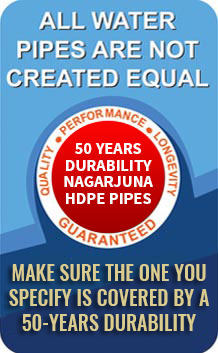BoreWell HDPE Pipes are flexible plastic pipes used for fluid and gas transfer. They are also used to replace aging concrete or steel main pipelines. They are made from thermoplastic HDPE (High-Density Polyethylene), it is a high degree of impermeability, and strong molecular bonds make them suitable for high-pressure pipelines.
HDPE pipes are used all around the world for applications such as water mains, gas mains, sewer mains, slurry transfer lines, rural irrigation, fire system supply lines, electrical and communication conduits, and stormwater and drainage pipes.
HDPE pipe is durable and flexible and can be bent on-site to a radius of twenty-five times the nominal pipe diameter. – For SDR11 and SDR17 pipes, at or below 20 °C ambient temperature. It provides cost savings compared to various pipe systems, some of which require threaded fittings, restrainers, or thrust blocks for minor changes in direction. Due to its high impact resistance and flexibility of HDPE pipe, it is well suited for installation in dynamic soils, including earthquake-prone areas.
According to the company that manufactures HDPE, HDPE systems are cost-effective to install and maintain long-term maintenance cost savings and also allow for inexpensive installation methods, such as HDD (Horizontal Directional Drilling), slippery, pipe Bursting, floating, and submerged pipes.
What are the different varieties of HDPE pipe?
The nominal pressure class – PN – up to PN 20 or 20 bar is often the standard specification to identify a class of BoreWell HDPE Pipes.
PE 100, PE 80, PE 63, PE 40, or PE 32 HDPE pipe can also be classed by the material used.
HDPE Pipes are Available in a Variety of Shapes and Sizes
HDPE Pipes are categorized into numerous pressure categories known as PN grades based on their maximum pressure withstanding capabilities. They are:
PN 2.5 – 2.5, bar maximum pressure
PN 4 – 4, bar maximum pressure
PN 6 – 6, bar maximum pressure
PN 10 – 10, bar maximum pressure
PN 16 – 16, bar maximum pressure
PN 20 – 20, bar maximum pressure
PN 25 represents a maximum pressure of 25 bar.
HDPE pipes are classified into the following categories based on the materials used:
PE 63 – pipe systems for medium pressures
PE 80 – gas pipe for natural gas distribution networks with pressures up to 4 bars or drinking water pipelines with pressures up to 16 bars – sewers, outfall pipes, and industrial pipes
PE 100 – pipe applications with high demands
PE is followed by, a series of values that represent the minimum needed strength in Bar at 200°C for a 50-year life span, as defined by ISO-4427.
At 200 degrees Celsius, the rated working pressure of HDPE pipes is calculated.
A derating factor (Table 2 below) is used to calculate the maximum pressure that the HDPE Pipe can withstand at higher temperatures.
Pipes Used for Borewells
Installation is simple, and quick
HDPE pipes are made to fit perfectly with suitable fittings, and careful installation avoids the risk of leaky joints.
HDPE pipes are also lightweight, making them simple to handle and supply at complex plumbing jobs.
It reduces the amount of manual labor and costs.
Domestic borewells, as well as agriculture and industrial operations, benefit from these pipes
Rust Free
Unlike metal pipes, which rust rapidly, when exposed to moisture or the environment, Borewell HDPE Pipes never rust.
Rusting weakens the surface of metal pipes, making them vulnerable to sudden bursts and splits.
On the other hand, HDPE pipes do not corrode, burst, or split, making them perfect for most situations.
Thermal Shock and High-Pressure Resistance
HDPE pipes are strong, lightweight, and long-lasting materials.
The capacity to withstand thermal shocks and severe pressure buildups is a quality that gives HDPE pipe its outstanding strength.
Without breaking or collapsing, these pipes can withstand a tremendous amount of wear and strain.




